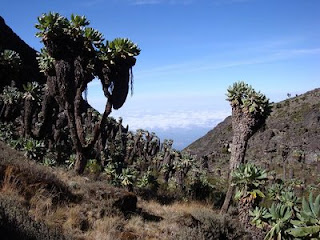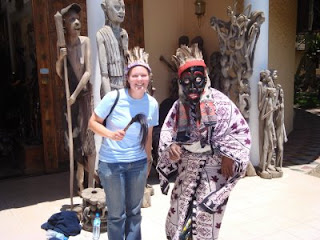
I just finished doing one of the hardest things I've ever had to do. Nathan and I reached Uhuru Peak - 5895 meters above sea level at 5:56am on September 27, 2008. The trip up was amazingly grueling and something that, just like others before me have said, "I'm glad I did it, but I'll never do that again!"
We climbed Mt. Kilimanjaro in style - well, as much style as the Machame route would allow, whose accommodations are tents every night in camps with only squat toilets. The climb was seven days long, but we had a team of two guides, one cook, and six porters waiting on us the entire time. Everyone treated us like VIPs, which was weird, but it wasn't hard to get used to someone waking you up every morning with a hot cup of tea or coffee in your sleeping bag.
We did nothing that makes camping time consuming or hard. We never had to set-up our tent, cook, get water, or carry our heavy bags. The team did everything for us. Porters could carry up to 20 kgs of stuff and they did it quickly - beating us to camp every single day and having popcorn, cookies, and warm wash water ready for an after-hike snack within minutes.
The food the entire time was amazing and they always tried to feed us too much. We always had a hot breakfast of things like eggs, toast, "sausages" (which is Africa is really a hot dog), and fruit. We usually had a packed lunch for the hike that consisted of mango juice, chicken, a sandwich, a tiny African banana, an orange, a hard-boiled egg (too many eggs!!), and a cornbread muffin. Dinner was always fantastic too: hot soup, a starch (noodles, rice, or potatoes), meat, and veggies spiced to perfection. The best part was the presentation. We had a waiter/porter named Timo who would come into our tent for every meal and set-up a tablecloth picnic complete with an array of barely-used condiments (tomato sauce, chili sauce, tea, coffee, Nido (powdered milk), Milo (Nestle Quick-like chocolate stuff), butter, peanut butter, jam, etc). You wouldn't believe me if I went on with the details, so I'll just leave you with this.

Ok....now...hike details:
Day 1: Machame Camp (~10,000 feet)
After arriving in Kilimanjaro National Park and waiting for about an hour for our permit and porters to arrive, we started the hike through pure rainforest. The forest was very different from what we have at home - lots of lichen-draped trees and neat flowers like the Impatian Kilimanjari:

The hike itself was not very difficult and it was made even easier by Kilimanjaro's famous motto: "pole pole" - walk slowly. We walked at a snail's pace up and still made it to camp by 5pm after starting at noon. We saw a few Blue Monkeys right at the gate, but beyond that, the tree cover was too thick to see anything else the rest of the way up. At the camp we were treated to our first in-tent candle-lit dinner (yes, we thought it was dangerous too). Tanzania gets dark at 6pm every day, and when we walked outside at 8pm, we were treated to the best stars I've ever seen - better even than in Glacier National Park.
Day 2: Machame Camp to Shira Camp (~12,000 ft)
This hike was five hours up a very steep trail. The best part was suddenly turning around to see a blanket of clouds about 1,000 feet below us and seeing Mt. Meru (around 1000 meters shorter than Kilimanjaro) sticking out of them! A weird plant called the Senecio showed up today, which only exists on Mt. Kilimanjaro and Mt. Kenya (picture under Day 3). There was also the best sunset of my life, I'll let the picture do the talking.

Day 3: Shira Camp to Barranco Camp (12,900 ft)
You know its going to be a tough day, when your guides pick up your packs in the morning and tell you they're too heavy. Today was our acclimatization day - walk high, sleep low. We hiked up to 15,100 feet to view the "Lava Tower", then back down to 12,900 ft to spend the night.

The air at 15,000 feet was definitely thinner and you almost had to start concentrating on breathing steadily. It was also quite cold and began to hail at one point, but in the end, it was a very good day because both of us felt fine after the hike, which gave us confidence that we could reach the summit without being hauled away on a stretcher. Barranco Camp was one of the coolest ones we had as we were surrounded by Senecio and Lobelia plants - both of which made the mountain start to seem like a strange fairytale jungle.

Day 4: Barranco Camp to Karanga Camp (13,900 ft)
Day four was an easy hike of just three hours. Although it began with a scramble straight up the side of one of one of the mountain's "barrancos" (ridges). The trail is called "Breakfast Trail" not because you do it right after breakfast, but because you get to see what everyone else had for breakfast. Ha! It wasn't that bad.

Day 5: Karanga Camp to Barafu Camp (15,000 ft)
Another easy hike of three hours to "base camp". At 11pm tonight we were awoken by Timo to get ready for the ascent that started at midnight.
Day 6: Barafu Camp - Summit (19,340 ft) - Mweka Camp
I use the word awoken loosely above. I got no sleep before our ascent because the camp was so cold. Once we started the ascent, I didn't feel sleepy at all. The stars were unbelievably beautiful and the lights from Moshi town below were stunning. Behind us and above us was a trail of headlamps. For the first 2.5 hours, the weather was great - I actually considered taking off one of the three pairs of pants I was wearing. However, very suddenly things took a turn for the worse. At about 2:30am, the trail became very steep and the wind picked up. It was so cold that the water inside my pack started to freeze. I had a very warm jacket on, but the wind against my face for the next four hours was frigid. It was so cold and long that you ended up only being able to worry about your next step. One more step, one more step, rest, one more step, whoops, don't forget to breathe, one more step. That's all we did for the next three and a half hours. It was dark, so you really had no way of knowing how much farther you had to go. At around 5:30am we reached what is known at Stella's Point. The top, but not the highest point, which is Uhuru Peak. That, was another 30 minutes walk away.
You think I'd be excited to almost be at the top of the mountain, but at this point all I could think about was how much my whole body hurt and how incredibly cold it was. It was so cold that once we reached Uhuru Peak your hands would freeze after taking them out of your gloves for one picture. I had no feeling of elation at the time whatsoever and even though the crater, glacier, and sunrise were awe-inspiring, I wasn't in the correct frame of mind to really appreciate them. All I could think about was get me the heck out of here!



We started down pretty quickly, but the hike down was also a grueling three hours back to camp. There, we bought a victory Coke (yes, they sold Coke, T-Shirts, and Kilimanjaro beer at every camp site), rested for an hour, ate lunch, and then, after already 9 hours of hiking that day, we hiked another 2.5 down to Mweka Camp, which was just above the rain forest.
Day 7: Mweka to Arusha
All I can say is thank goodness we're off that mountain! Actually, it was an incredible experience that I'm glad, in retrospect, we finished successfully. It was a test of wills and we overcame extreme physical challenge to get to the top and I'm very glad I was able to do it. The hikes every other day besides summit day were amazingly beautiful and worth it. My recommendation to future hikers? Unless you really need to check "Climb Kilimanjaro" off your life list, forget the top, it's anti-climactic and horribly difficult. Do a couple of day hikes, camp, take in the view. Your feet, lungs, and head will thank you later!





















